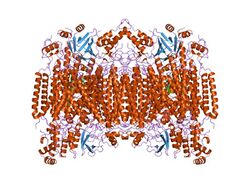Biology:COX5B
| Cytochrome c oxidase subunit Vb | |||||||||||
|---|---|---|---|---|---|---|---|---|---|---|---|
 Structure of the 13-subunit oxidized cytochrome c oxidase.[1] | |||||||||||
| Identifiers | |||||||||||
| Symbol | COX5B | ||||||||||
| Pfam | PF01215 | ||||||||||
| InterPro | IPR002124 | ||||||||||
| PROSITE | PDOC00663 | ||||||||||
| SCOP2 | 1occ / SCOPe / SUPFAM | ||||||||||
| OPM superfamily | 4 | ||||||||||
| OPM protein | 1v55 | ||||||||||
| CDD | cd00924 | ||||||||||
| |||||||||||
Cytochrome c oxidase subunit 5B, mitochondrial is an enzyme in humans that is a subunit of the cytochrome c oxidase complex, also known as Complex IV, the last enzyme in the mitochondrial electron transport chain.[2] In humans, cytochrome c oxidase subunit 5B is encoded by the COX5B gene.
Structure
The enzyme weighs 14 kDa and is composed of 129 amino acids.[3][4] The protein is a subunit of Complex IV, which consists of 13 mitochondrial- and nuclear-encoded subunits.[2] The sequence of subunit Vb is well conserved and includes three conserved cysteines that coordinate the zinc ion.[5][6] Two of these cysteines are clustered in the C-terminal section of the subunit.
Gene
 Generic protein structure example |
The COX5B gene, located on the q arm of chromosome 2 in position 11.2, is made up of 4 exons and is 2,137 base pairs in length.[2]
Function
Cytochrome c oxidase (COX) is the terminal enzyme of the mitochondrial respiratory chain. It is a multi-subunit enzyme complex that couples the transfer of electrons from cytochrome c to oxygen and contributes to a proton electrochemical gradient across the inner mitochondrial membrane to drive ATP synthesis via protonmotive force. The mitochondrially-encoded subunits perform the electron transfer of proton pumping activities. The functions of the nuclear-encoded subunits are unknown but they may play a role in the regulation and assembly of the complex.[2]
Summary reaction:
- 4 Fe2+-cytochrome c + 8 H+in + O2 → 4 Fe3+-cytochrome c + 2 H2O + 4 H+out[7]
Clinical significance
COX5A and COX5B are involved in the regulation of cancer cell metabolism by Bcl-2.[8]
The Trans-activator of transcription protein (Tat) of human immunodeficiency virus (HIV) inhibits cytochrome c oxidase (COX) activity in permeabilized mitochondria isolated from both mouse and human liver, heart, and brain samples.[9]
Interactions
COX5B has been shown to interact with Androgen receptor.[10]
References
- ↑ "Application of an automatic molecular-replacement procedure to crystal structure analysis of cytochrome c2 from Rhodopseudomonas viridis". Acta Crystallogr. D 50 (Pt 3): 271–5. May 1994. doi:10.1107/S0907444993013952. PMID 15299438. http://journals.iucr.org/d/issues/1994/03/00/as0652/as0652.pdf.
- ↑ 2.0 2.1 2.2 2.3 "Entrez Gene: COX5B cytochrome c oxidase subunit Vb". https://www.ncbi.nlm.nih.gov/sites/entrez?Db=gene&Cmd=ShowDetailView&TermToSearch=1329.
- ↑ ]"Integration of cardiac proteome biology and medicine by a specialized knowledgebase". Circulation Research 113 (9): 1043–53. Oct 2013. doi:10.1161/CIRCRESAHA.113.301151. PMID 23965338.
- ↑ "Cytochrome c oxidase subunit 5B, mitochondrial". Cardiac Organellar Protein Atlas Knowledgebase (COPaKB). https://amino.heartproteome.org/web/protein/P10606.
- ↑ "The most conserved nuclear-encoded polypeptide of cytochrome c oxidase is the putative zinc-binding subunit: primary structure of subunit V from the slime mold Dictyostelium discoideum". Biochim. Biophys. Acta 1129 (1): 100–104. 1991. doi:10.1016/0167-4781(91)90220-G. PMID 1661610.
- ↑ "The whole structure of the 13-subunit oxidized cytochrome c oxidase at 2.8 A". Science 272 (5265): 1136–1144. 1996. doi:10.1126/science.272.5265.1136. PMID 8638158. Bibcode: 1996Sci...272.1136T.
- ↑ Pratt, Donald Voet, Judith G. Voet, Charlotte W. (2013). "18". Fundamentals of biochemistry : life at the molecular level (4th ed.). Hoboken, NJ: Wiley. pp. 581–620. ISBN 9780470547847.
- ↑ "Involvement of cytochrome c oxidase subunits Va and Vb in the regulation of cancer cell metabolism by Bcl-2". Cell Death and Differentiation 17 (3): 408–20. Mar 2010. doi:10.1038/cdd.2009.132. PMID 19834492.
- ↑ "HIV-1 Tat protein directly induces mitochondrial membrane permeabilization and inactivates cytochrome c oxidase". Cell Death & Disease 3 (3): e282. 2012. doi:10.1038/cddis.2012.21. PMID 22419111.
- ↑ "Cytochrome c oxidase subunit Vb interacts with human androgen receptor: a potential mechanism for neurotoxicity in spinobulbar muscular atrophy". Brain Res. Bull. 56 (3–4): 285–97. 2001. doi:10.1016/S0361-9230(01)00583-4. PMID 11719263.
Further reading
- "Structure of the human cytochrome c oxidase subunit Vb gene and chromosomal mapping of the coding gene and of seven pseudogenes". Genomics 10 (1): 1–9. 1991. doi:10.1016/0888-7543(91)90476-U. PMID 1646156.
- "Immunohistochemical demonstration of fibre type-specific isozymes of cytochrome c oxidase in human skeletal muscle". Histochemistry 94 (2): 211–5. 1990. doi:10.1007/BF02440190. PMID 2162812.
- "Sequence of cDNAs encoding subunit Vb of human and bovine cytochrome c oxidase". Gene 65 (1): 1–11. 1988. doi:10.1016/0378-1119(88)90411-8. PMID 2840351.
- "Human liver protein map: update 1993". Electrophoresis 14 (11): 1216–22. 1993. doi:10.1002/elps.11501401181. PMID 8313870.
- "Phylogenetic footprinting of the human cytochrome c oxidase subunit VB promoter". Arch. Biochem. Biophys. 333 (1): 152–62. 1996. doi:10.1006/abbi.1996.0376. PMID 8806766.
- "Quantitative decrease of human cytochrome c oxidase during development: evidences for a post-transcriptional regulation". Biochim. Biophys. Acta 1318 (1–2): 191–201. 1997. doi:10.1016/S0005-2728(96)00136-3. PMID 9030264.
- "Autocrine gastrins in colon cancer cells Up-regulate cytochrome c oxidase Vb and down-regulate efflux of cytochrome c and activation of caspase-3". J. Biol. Chem. 275 (42): 32491–8. 2000. doi:10.1074/jbc.M002458200. PMID 10915781.
- "Cytochrome c oxidase subunit Vb interacts with human androgen receptor: a potential mechanism for neurotoxicity in spinobulbar muscular atrophy". Brain Res. Bull. 56 (3–4): 285–97. 2002. doi:10.1016/S0361-9230(01)00583-4. PMID 11719263.
- "Large-scale mapping of human protein-protein interactions by mass spectrometry". Mol. Syst. Biol. 3 (1): 89. 2007. doi:10.1038/msb4100134. PMID 17353931.
External links
- Human COX5B genome location and COX5B gene details page in the UCSC Genome Browser.
- Mass spectrometry characterization of COX5B at COPaKB
- Cytochrome c oxidase subunit Vb in PROSITE
- Overview of all the structural information available in the PDB for UniProt: P10606 (Cytochrome c oxidase subunit 5B, mitochondrial) at the PDBe-KB.
This article incorporates text from the United States National Library of Medicine, which is in the public domain.
 |

